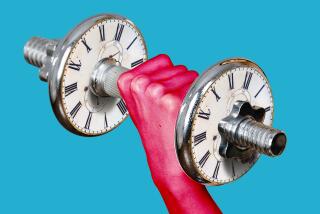Fast Results From Going ‘Super Slow’
- Share via
Strength training has gone mainstream. But although most fitness experts agree that it is important to include weightlifting along with aerobics and stretching for a complete fitness regimen, there is an abundance of opinions on the ideal approach to using those weights.
One school of thought says that the best results come from the tried-and-true, multiple-set training regimen. In this traditional approach, you perform two or more sets of eight to 12 repetitions with short rests between sets. Others believe that single-set training (one set of eight to 12 reps) is the way to go when you want to save time and still increase strength. Pyramid training is yet another technique often used by serious athletes. It involves lifting heavy weights with few reps until fatigue sets in, then continuing with lighter weights and more reps.
The newest approach being talked about in and out of gyms around the country is a strength-training practice called “super slow.” In it, you make each repetition last 14 seconds--10 seconds on the “lifting” phase and four seconds on the “lowering” phase. The weight should be heavy enough so your muscles are fatigued by one set of four to six of these reps. Fans of the slow-training technique say it is a safe and effective means of building strength, since reducing momentum creates more muscle tension.
Los Angeles-based trainer Vinnie Tortorich incorporates slow training into many of the specialized programs he creates for celebrities and other clients who need results in a short amount of time. He explains that the longer you can keep the muscle tissue stimulated, the better the strength gain. However, he is quick to add that the theory “works better on paper than in practice.” Even though his clients get excellent results with super-slow training, he says, it is so mentally tedious that it is hard for them to stick with the program for more than six weeks. Some of his clients “would rather have a root canal than endure the torture of super-slow training,” he jokes.
As a result, he alternates four to six weeks of slow training with six weeks of standard weight training for some of his clients. He relies on the slow method as a sure-fire way to help actors who may only have a month to get in shape. He also finds it works well for beginners learning proper lifting techniques and for longtime clients who want to blast past a strength plateau.
In general, I’ve found that super-slow training has its pros and cons. Studies confirm that moving your muscles slowly builds more strength than moving them quickly. Because working slowly allows you to concentrate on technique, it also reduces your risk of injury. But, yes, it can be grueling. I agree with Tortorich’s concept of mixing up your weight routine. Alternating super-slow with traditional lifting methods can be a useful change of pace and keep you out of an exercise rut.
If you want to try super-slow training, here are two exercises to get you started. Both focus on this month’s featured body part, the thigh, and I’ve included both the standard method and the super-slow method for each move. Regardless of the technique, remember to give your legs a day of rest between each strength-training session.
Quadricep Extensions: Attach 5-to 10-pound ankle weights to your legs. Sit upright on a chair or bench. Place one foot flat on the floor, pull in your abdominals and maintain a straight back. Slowly lift your other foot until the knee is straight but not locked. For the super-slow technique, take 10 seconds to fully complete the extension. Then take four seconds to lower the foot to the floor. Repeat four to six times. For the standard technique, lift the foot in two seconds, pause at the top of the contraction for one second and lower down in four seconds. Repeat eight to 12 times. Do two or three sets with one minute of rest between sets. In either version, make sure you turn your toes inward just slightly so you don’t twist, and hurt, your kneecap.
Hamstring Curl: Attach 5-to 10-pound ankle weights. Balance on one leg holding on to a sturdy surface. Slowly bend the other knee, aiming your heel toward your buttocks. Keep your inner legs parallel to each other and your knees close together as you lift your foot as high as you can. For the super-slow technique, take 10 seconds to lift your heel and four seconds to lower your heel to the ground. Repeat four to six times. In the standard technique, take two seconds to lift the foot, pause at the top of the contraction and lower the heel in four seconds. Do two or three sets of eight to 12 reps per set. Rest one minute between sets.
Go ahead and experiment with the super-slow method. Trying a new approach may be just what you need to push yourself to a new level. Keep it up, and you’ll soon see your muscles getting firmer and feel the added strength you’ve developed.
*
Next month: Calves. Previous columns in this series can be found at www.latimes.com/rightmoves.
Joan Voight, a San Francisco- based journalist, contributed to this column. Karen Voight is a Los Angeles-based fitness expert whose latest video is “Pilates: Abdominals & Back.” She can be reached at kvoightla@aol.com. Her column appears the first Monday of the month.


